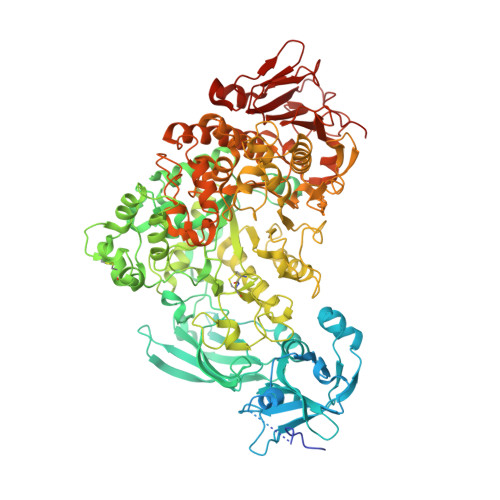Crystal structure of pullulanase: evidence for parallel binding of oligosaccharides in the active site
Mikami, B., Iwamoto, H., Malle, D., Yoon, H.-J., Demirkan-Sarikaya, E., Mezaki, Y., Katsuya, Y.(2006) J Mol Biology 359: 690-707
- PubMed: 16650854
- DOI: https://doi.org/10.1016/j.jmb.2006.03.058
- Primary Citation of Related Structures:
2FGZ, 2FH6, 2FH8, 2FHB, 2FHC, 2FHF - PubMed Abstract:
The crystal structures of Klebsiella pneumoniae pullulanase and its complex with glucose (G1), maltose (G2), isomaltose (isoG2), maltotriose (G3), or maltotetraose (G4), have been refined at around 1.7-1.9A resolution by using a synchrotron radiation source at SPring-8. The refined models contained 920-1052 amino acid residues, 942-1212 water molecules, four or five calcium ions, and the bound sugar moieties. The enzyme is composed of five domains (N1, N2, N3, A, and C). The N1 domain was clearly visible only in the structure of the complex with G3 or G4. The N1 and N2 domains are characteristic of pullulanase, while the N3, A, and C domains have weak similarity with those of Pseudomonas isoamylase. The N1 domain was found to be a new type of carbohydrate-binding domain with one calcium site (CBM41). One G1 bound at subsite -2, while two G2 bound at -1 approximately -2 and +2 approximately +1, two G3, -1 approximately -3 and +2 approximately 0', and two G4, -1 approximately -4 and +2 approximately -1'. The two bound G3 and G4 molecules in the active cleft are almost parallel and interact with each other. The subsites -1 approximately -4 and +1 approximately +2, including catalytic residues Glu706 and Asp677, are conserved between pullulanase and alpha-amylase, indicating that pullulanase strongly recognizes branched point and branched sugar residues, while subsites 0' and -1', which recognize the non-reducing end of main-chain alpha-1,4 glucan, are specific to pullulanase and isoamylase. The comparison suggested that the conformational difference around the active cleft, together with the domain organization, determines the different substrate specificities between pullulanase and isoamylase.
- Laboratory of Food Quality Design and Development, Graduate School of Agriculture, Kyoto University, Uji, Kyoto 611-0011, Japan. mikami@kais.kyoto-u.ac.jp
Organizational Affiliation:

















